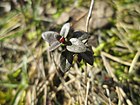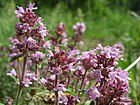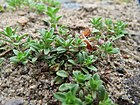Note: This is a project under development. The articles on this wiki are just being initiated and broadly incomplete. You can Help creating new pages.
Thymus serpyllum
Thymus serpyllum is an evergreen shrub that can grow up to 0.10 metres tall. It is harvested from the wild for local use as a food, medicine and source of materials.
Contents
- 1 Uses
- 2 Parts Used
- 3 Chemical Composition
- 4 Common names
- 5 Properties
- 6 Habit
- 7 Identification
- 8 List of Ayurvedic medicine in which the herb is used
- 9 Where to get the saplings
- 10 Mode of Propagation
- 11 How to plant/cultivate
- 12 Commonly seen growing in areas
- 13 Photo Gallery
- 14 References
- 15 External Links
Uses
Bronchitis, Catarrh, Laryngitis, Indigestion, Painful menstruation, Colic, Hangovers, Alcoholism, Gum infections, [[:Category:Ayurvedic Herbs known to be helpful to treat |]], [[:Category:Ayurvedic Herbs known to be helpful to treat |]].[1]
Parts Used
Chemical Composition
48 compounds were identified. Results showed that oxygenated monoterpenes are the major portion of all EOs samples, with highest content observed in T. algeriensis (74.61%), and similar content in T. speryllum and T. vulgaris (54.49% and 58.11%, respectively). [2]
Common names
| Language | Common name |
|---|---|
| Kannada | |
| Hindi | |
| Malayalam | |
| Tamil | |
| Telugu | |
| Marathi | |
| Gujarathi | |
| Punjabi | |
| Kashmiri | |
| Sanskrit | |
| English |
Properties
Reference: Dravya - Substance, Rasa - Taste, Guna - Qualities, Veerya - Potency, Vipaka - Post-digesion effect, Karma - Pharmacological activity, Prabhava - Therepeutics.
Dravya
Rasa
Guna
Veerya
Vipaka
Karma
Prabhava
Habit
[[:Category:Habit - |]]
Identification
Leaf
| Kind | Shape | Feature |
|---|---|---|
Flower
| Type | Size | Color and composition | Stamen | More information |
|---|---|---|---|---|
| {{{5}}} |
Fruit
| Type | Size | Mass | Appearance | Seeds | More information |
|---|---|---|---|---|---|
Other features
List of Ayurvedic medicine in which the herb is used
Where to get the saplings
Mode of Propagation
Seeds, Cuttings of young shoots, Cuttings of half-ripe wood, Air layering.
How to plant/cultivate
Requires a light well-drained preferably calcareous soil in a sunny position. Succeeds in dry soils. Grows well between stepping stones on paths, tolerating light treading.[4]
Commonly seen growing in areas
Dry stony ground, Open sandy heaths.
Photo Gallery
References
- ↑ Indian Medicinal Plants by C.P.Khare
- ↑ Chemical constituents
- ↑ [Morphology]
- ↑ Cultivation
External Links
- Ayurvedic Herbs known to be helpful to treat Bronchitis
- Ayurvedic Herbs known to be helpful to treat Catarrh
- Ayurvedic Herbs known to be helpful to treat Laryngitis
- Ayurvedic Herbs known to be helpful to treat Indigestion
- Ayurvedic Herbs known to be helpful to treat Painful menstruation
- Ayurvedic Herbs known to be helpful to treat Colic
- Ayurvedic Herbs known to be helpful to treat Hangovers
- Ayurvedic Herbs known to be helpful to treat Alcoholism
- Ayurvedic Herbs known to be helpful to treat Gum infections
- Ayurvedic Herbs known to be helpful to treat
- Herbs with Leaves used in medicine
- Habit -
- Index of Plants which can be propagated by Seeds
- Index of Plants which can be propagated by Cuttings of young shoots
- Index of Plants which can be propagated by Cuttings of half-ripe wood
- Index of Plants which can be propagated by Air layering
- Herbs that are commonly seen in the region of Dry stony ground
- Herbs that are commonly seen in the region of Open sandy heaths
- Herbs






